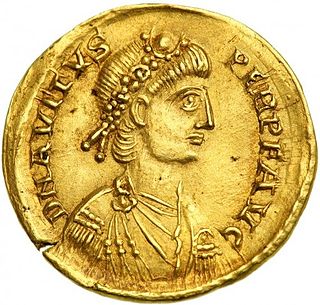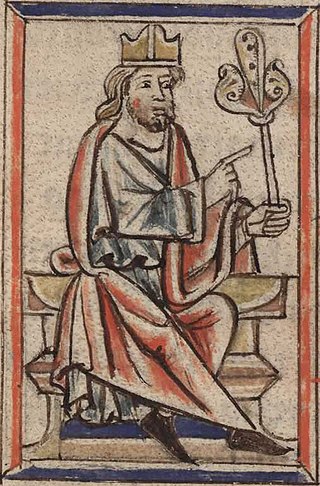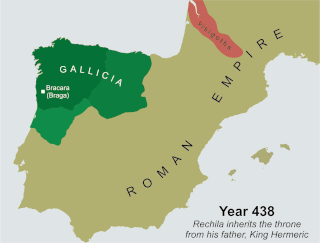Related Research Articles

Alaric II was the King of the Visigoths from 484 until 507. He succeeded his father Euric as king of the Visigoths in Toulouse on 28 December 484; he was the great-grandson of the more famous Alaric I, who sacked Rome in 410. He established his capital at Aire-sur-l'Adour in Aquitaine. His dominions included not only the majority of Hispania but also Gallia Aquitania and the greater part of an as-yet undivided Gallia Narbonensis.

The Goths were Germanic people who played a major role in the fall of the Western Roman Empire and the emergence of medieval Europe.

The Suebi or Suebians were a large group of Germanic peoples originally from the Elbe river region in what is now Germany and the Czech Republic. In the early Roman era they included many peoples with their own names such as the Marcomanni, Quadi, Hermunduri, Semnones, and Lombards. New groupings formed later, such as the Alamanni and Bavarians, and two kingdoms in the Migration Period were simply referred to as Suebian.

The Visigoths were a Germanic people united under the rule of a king and living within the Roman Empire during late antiquity. The Visigoths first appeared in the Balkans, as a Roman-allied barbarian military group united under the command of Alaric I. Their exact origins are believed to have been diverse but they probably included many descendants of the Thervingi who had moved into the Roman Empire beginning in 376 and had played a major role in defeating the Romans at the Battle of Adrianople in 378. Relations between the Romans and Alaric's Visigoths varied, with the two groups making treaties when convenient, and warring with one another when not. Under Alaric, the Visigoths invaded Italy and sacked Rome in August 410.

Eparchius Avitus was Roman emperor of the Western Empire from July 455 to October 456. He was a senator of Gallic extraction and a high-ranking officer both in the civil and military administration, as well as Bishop of Piacenza.

Wallia, Walha or Vallia, was king of the Visigoths from 415 to 418, earning a reputation as a great warrior and prudent ruler. He was elected to the throne after Athaulf and Sigeric were both assassinated in 415. One of Wallia's most notable achievements was negotiating a foedus with the Roman emperor Honorius in 416. This agreement allowed the Visigoths to settle in Aquitania, a region in modern-day France, in exchange for military service to Rome. This settlement marked a significant step towards the eventual establishment of a Visigothic kingdom in the Iberian Peninsula. He was succeeded by Theodoric I.
This is a historical timeline of the Iberian Peninsula during the period of the post-Imperial kingdoms.

Hermeric was the king of the Suevi from at least 419 and possibly as early as 406 until his abdication in 438.

Theudis, was king of the Visigoths in Hispania from 531 to 548.

Liuvigild, Leuvigild, Leovigild, or Leovigildo, was a Visigothic King of Hispania and Septimania from 568 to 586. Known for his Codex Revisus or Code of Leovigild, a law allowing equal rights between the Visigothic and Hispano-Roman population, his kingdom covered modern Portugal and most of modern Spain down to Toledo. Liuvigild ranks among the greatest Visigothic kings of the Arian period.

Rechila was the Suevic king of Galicia from 438 until his death. There are few primary sources for his life, but Hydatius was a contemporary Christian (non-Arian) chronicler in Galicia.

Rechiar or Flavius Rechiarius was the third Suevic king of Gallaecia, from 448 until his death, and also the first one to be born in Gallaecia. He was one of the most innovative and belligerent of the Suevi monarchs. Hydatius, the contemporary bishop and chronicler from Galicia who is the sole contemporary source for biographical details of Rechiar, established his reputation as that of a barbarian with little sense of Roman law, culture, or custom; accusations already discredited, but very common at that time.
Maldras was the Suevic king of Galicia from 456 until his death. After the execution of Rechiar by the victorious Visigoths, the Suevi are said to have established Maldras on the throne. During his reign the Suevic nation became fragmented.

The Kingdom of the Suebi, also called the Kingdom of Galicia or Suebi Kingdom of Galicia, was a Germanic post-Roman kingdom that was one of the first to separate from the Roman Empire. Based in the former Roman provinces of Gallaecia and northern Lusitania, the de facto kingdom was established by the Suebi about 409, and during the 6th century it became a formally declared kingdom identifying with Gallaecia. It maintained its independence until 585, when it was annexed by the Visigoths, and was turned into the sixth province of the Visigothic Kingdom in Hispania.
Aioulf or Ag(r)iwulf was an obscure king of Galicia from 456. In 448, after eight years in captivity, the Roman ambassador Censorius was executed by one Agiulf at Seville (Hispalis). This Agiulf has sometimes been identified with Aioulf.
Richimund or Rechimund was a Suevic leader in Galicia from 457 until about 464. He was not recorded as a king (rex), though Hydatius wrote that inter Frumarium et Rechimundum oritur de regni potestate dissensio. In 457 the Suevi split into two factions, one headed by Maldras raiding Lusitania and another led by Framta remaining in Galicia. After a few months of rule, Framta died and Rechimund appeared as his successor. While it is possible that the Suevi were living under a diarchy, it is more likely that the two factions remained independent of one another. Maldras' eventual successor, Frumar, was also not described as a king, but in 464 or thereabouts the entire Suevic nation was unified under a king named Remismund. Presumably, Rechimund and Frumar had battled for the throne and both had been eliminated, paving the way for Remismund. Some scholars have equated Remismund with Rechimund, but this seems far-fetched.
Remismund was the Suevic king of Galicia from c. 464 until his death.

Theodemir or Theodemar was one of the last Suevic kings of Galicia and one of the first Chalcedonian Christians to hold the title. He succeeded Ariamir sometime between the end of May 561 and the year 566 and ruled until his death.
Veremund or Veremundus was a Suevic king of Galicia around 500. His existence is conjectured on the basis of a sixth-century inscription discovered at Salvador de Vairão. The date in the inscription is interpreted as either 485 or 535. Some scholars have dated the inscription to the eighth century, arguing that the Veremundus of the inscription is King Bermudo I of Asturias.

The Gothic War in Spain of 456 was a military operation of the Visigoths commissioned by the West Roman emperor Avitus. This operation consisted of an extensive campaign aimed at reclaiming the Spanish provinces of Lusitania and Betica that were in the hands of the Suebi and threatened Roman power in the provinces of Cartaginensis and Tarraconensis. The main players in this war were Theoderic II who led the army of the Visigoths and Rechiar the king of the Suebi. The Visigothic army was supported by Franks and Burgundian auxiliary troops.
References
- Arias, Jorge C. "Identity and Interactions: The Suevi and the Hispano-Romans." University of Virginia: Spring 2007.
- Ferreiro, Alberto. "Braga and Tours: Some Observations on Gregory's De virtutibus sancti Martini." Journal of Early Christian Studies . 3 (1995), p. 195–210.
- Mathisen, Ralph W. "Barbarian Bishops and the Churches 'in Barbaricis Gentibus' During Late Antiquity." Speculum , Vol. 72, No. 3. (Jul., 1997), pp. 664–697.
- Thompson, E. A. "The End of Roman Spain: Part IV, Conclusion." Nottingham Mediaeval Studies, xxiii (1979), pp. 1–21. Reprinted as "Spain and Britain" in Romans and Barbarians: The Decline of the Western Empire (pp. 208–229). Madison: University of Wisconsin Press, 1982. ISBN 0-299-08700-X.
- Thompson, E. A. "Barbarian Collaborators and Christians." Romans and Barbarians: The Decline of the Western Empire (pp. 230–250). Madison: University of Wisconsin Press, 1982. ISBN 0-299-08700-X.
- Thompson, E. A. "The Conversion of the Spanish Suevi to Catholicism." Visigothic Spain: New Approaches. ed. Edward James. Oxford: Oxford University Press, 1980. ISBN 0-19-822543-1.
- Wolfram, Herwig. History of the Goths. Thomas J. Dunlap, trans. Berkeley: University of California Press, 1988.